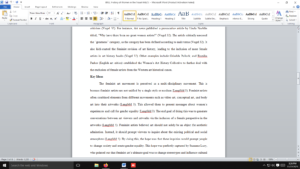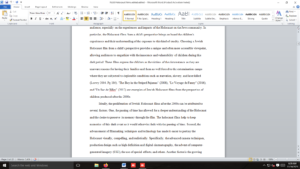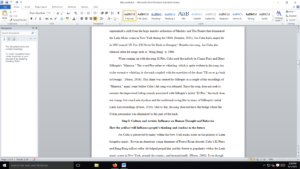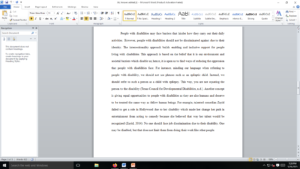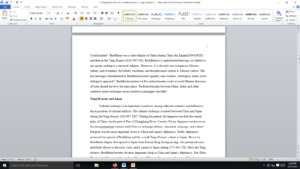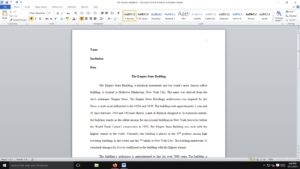VIS127P Arts of Japan
Guidelines for Your Term Paper (30%)
Length: 5-6 pages of text in length, typed, 1.5 spaced, 12 font , not including a Works Cited Page
**At LEAST 4 academic references / sources for your paper. These sources include peer-reviewed books, periodical journals, and museum journals. An example would be the Art Bulletin or Google Scholar. These sources are written by and further the research of scholars.
The grade will be based on your clarity of presentation, perceptive use of
existing scholarship, effectiveness of the evidence you present, the quality and persuasiveness of
your argument, and the soundness of your conclusions.
Topic: I began wondering how ancient China influenced Japan in terms of artworks and architecture. My research paper will focus specifically on the relationship between the Tang dynasty of China and Japan, including the deep relations between the two countries and how the Tang civilization shapes modern Japanese artworks. I will elaborate on the topic by providing a brief history of the two and examine the similarities between artworks and architecture during that period.
For the essay, please consider focusing on one or two issues that are most relevant to the development of aesthetics and try to be as specific as possible – what kind of artworks are you referring to (i.e., Buddhist art, Buddhist architecture, scroll paintings, etc.) Consider choosing one type of art for your paper in order to develop a detailed analysis.
This research paper will include the following:
- Introduction
- The history between Tang Dynasty and Japan
- Artworks and architecture under Tang influences
- Comparing similarities and differences
- Conclusion
You should develop an issue related to but not duplicating the
course material (Japanese art from the Jomon period to the 18th century). Typical topics for term
papers (among many other possibilities) might include a close study of a single monument or
work of art, examination of developments within a single innovative artistic style, a particular
aspect of a single artist’s work, or a carefully delimited discussion about the development of a
particular type of subject matter, to mention only a few possibilities. Please make good use of
provided references materials and digital resources available through the library website and
major museum sites. The grade will be based on your clarity of presentation, perceptive use of
existing scholarship, effectiveness of the evidence you present, the quality and persuasiveness of
your argument, and the soundness of your conclusions.
In your research, use all the resources available to you in the library and on the web to find
additional material about the topic in the form of books, articles, and images.
Your final paper, like all good writing, should be organized to tell a story or to solve a problem,
with an introduction, presentation of the evidence, and clear conclusion. Achieving this goal
usually requires careful editing and some rewriting, so don’t wait until the night before the paper
is due to start writing, but budget your research time so that you can get to work on your draft as
early as possible. Please edit the paper carefully and critically. This will probably lead you to do
some reorganization, so please leave yourself adequate time to do so.
Technical matters:
The paper should be roughly 6-8 pages in length. Longer is acceptable, if needed, after editing,
but not required.
Please type your paper in a font of 12 pitch, 1.5 spaced, and paginated.
***Please use the standard scholarly note and bibliography format and cite all your sources,
including both notes and bibliography. You may use either MLA or Chicago Style for notes.
The textbook can be used as a model for the formats of bibliography and Chicago Style notes.
All sources, including online ones, should be documented.
Be careful and critical of your sources, especially online sources. Wikipedia is not scholarly and
should not be cited as a primary source, although the better articles sometimes have bibliography
that is well worth consulting. Academic, museum, and peer-reviewed sources should be your
primary references. When in doubt, please ask.
Please include illustrations of the works of art you discuss or that support your argument. You
should identify each illustration in a caption or list of illustrations in a format similar to what you see in the textbook. In addition to artist, title, medium and format, date, and dimensions, you should include the collection that owns the work, if known, and the source of your illustration (whether print and internet). Please do not insert the illustrations in the text but append them at the end.
Examples- Format of References:
Book:
Varley, Paul. Japanese Culture. Honolulu: University of Hawaii Press, 4th edition, 2000
Book Chapters:
Wu, Hung. “The Origins of Chinese Painting (Paleolithic Period to Tang Dynasty),” in Three
Thousand Years of Chinese Painting, eds., Yang Xin and others. New Haven and London: Yale
University Press, 1997. pp. 15-86.
Journal Article:
Hay, Jonathan. “Ambivalent Icons: Works of Five Chinese Artists Based in the United States.”
Orientations 23, no.7 (July 1992): 37-43.
Format of Citations:
MLA (in-essay citation):
(Varley, 68) or (Varley, 2000, 85)
Chicago Style (footnotes or endnotes):
Varley, Japanese Culture, 164
or
Hung, “The Origins of Chinese Painting (Paleolithic Period to Tang Dynasty),” 75
Requirements: 5-6 pages
Answer preview
Cultural exchange is an important occurrence among adjacent countries and influences the acquisition of cultural artifacts. The cultural exchange occurred between China and Japan during the Tang dynasty (618-907 CE)[1]. During this period, the Japanese traveled the central plain of China via the port of Port of Changjiang River. Country Wa (as Japanese was known at the time)maintained contact with China to exchange religion, education, language, and culture[2]. Religion was the most important factor in China and Japan’s diplomacy. Public diplomacy promoted the spread of Buddhism and the overall Tang Dynasty culture to Japan. However, Buddhism religion first spread to Japan from Korean King Syong-myong, who presented icons and ritual objects to the royal court, and it spread in Japan during (572–621 CE). Since the Tang dynasty, Buddhism became the most important thing in China and Japan’s diplomacy. Jian Zhen Monk visited Japan via the southeast littoral of China to Japan across the oceans[3]. In the subsequent centuries, Japanese Monks visited China during the Tang dynasty bringing Buddhist texts and images[4].
[1] Li, Xiao. Studies on the History and Culture Along the Continental Silk Road. Basingstoke: Springer Nature, 2020.
[2] Huang, Yuyun. “Study on Local Records of the Same Name in Wei, Jin, Sui and Tang Dynasties.” The Journal of Society for Humanities Studies in East Asia 43 (2018), 247-273. doi:10.52639/jeah.2018.06.43.247.
[3] Ibid
[4] Ibid
[2346 Words]
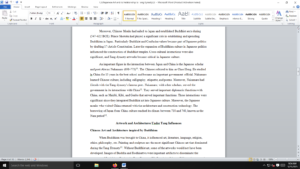
Artworks and architecture


